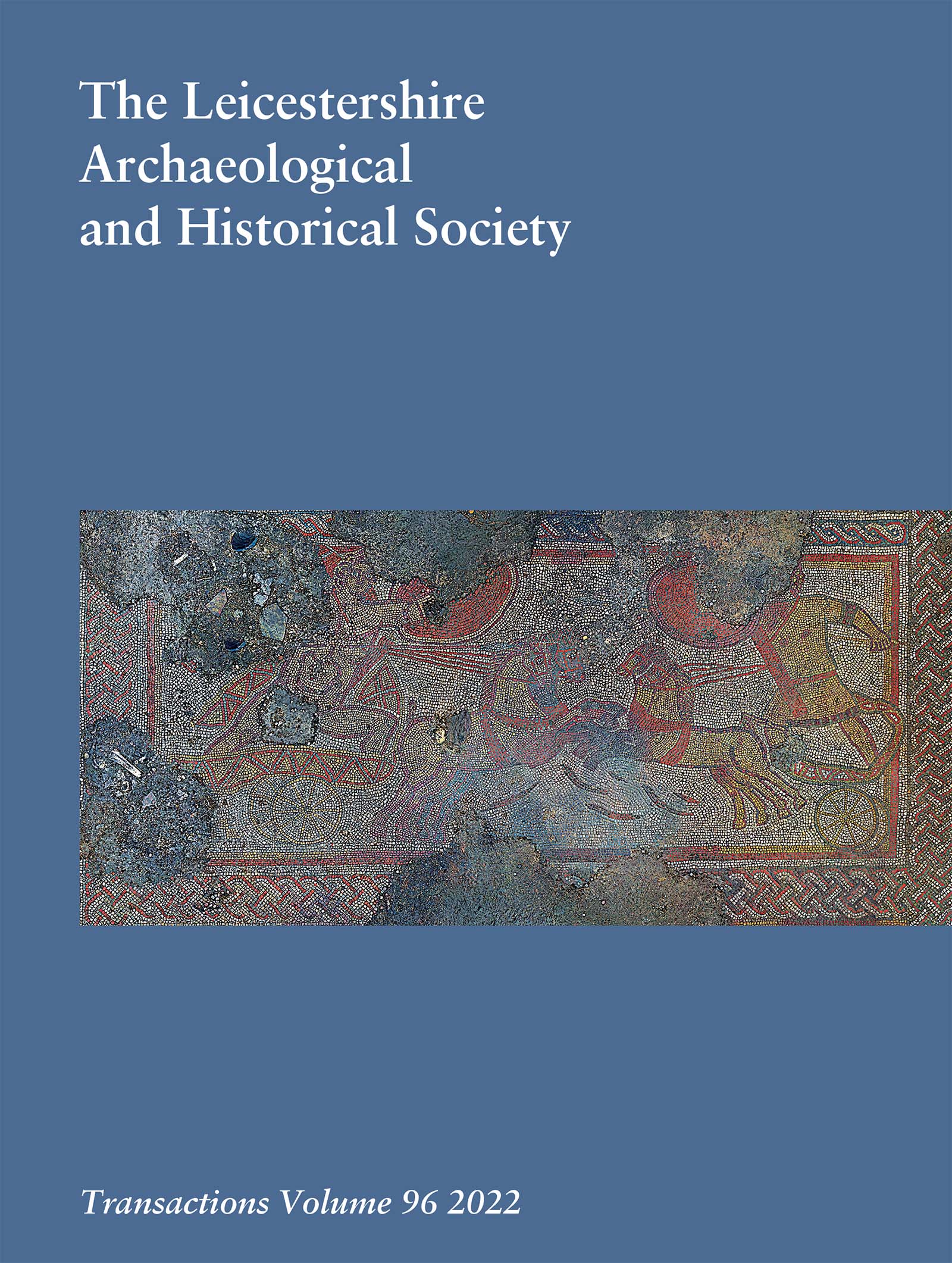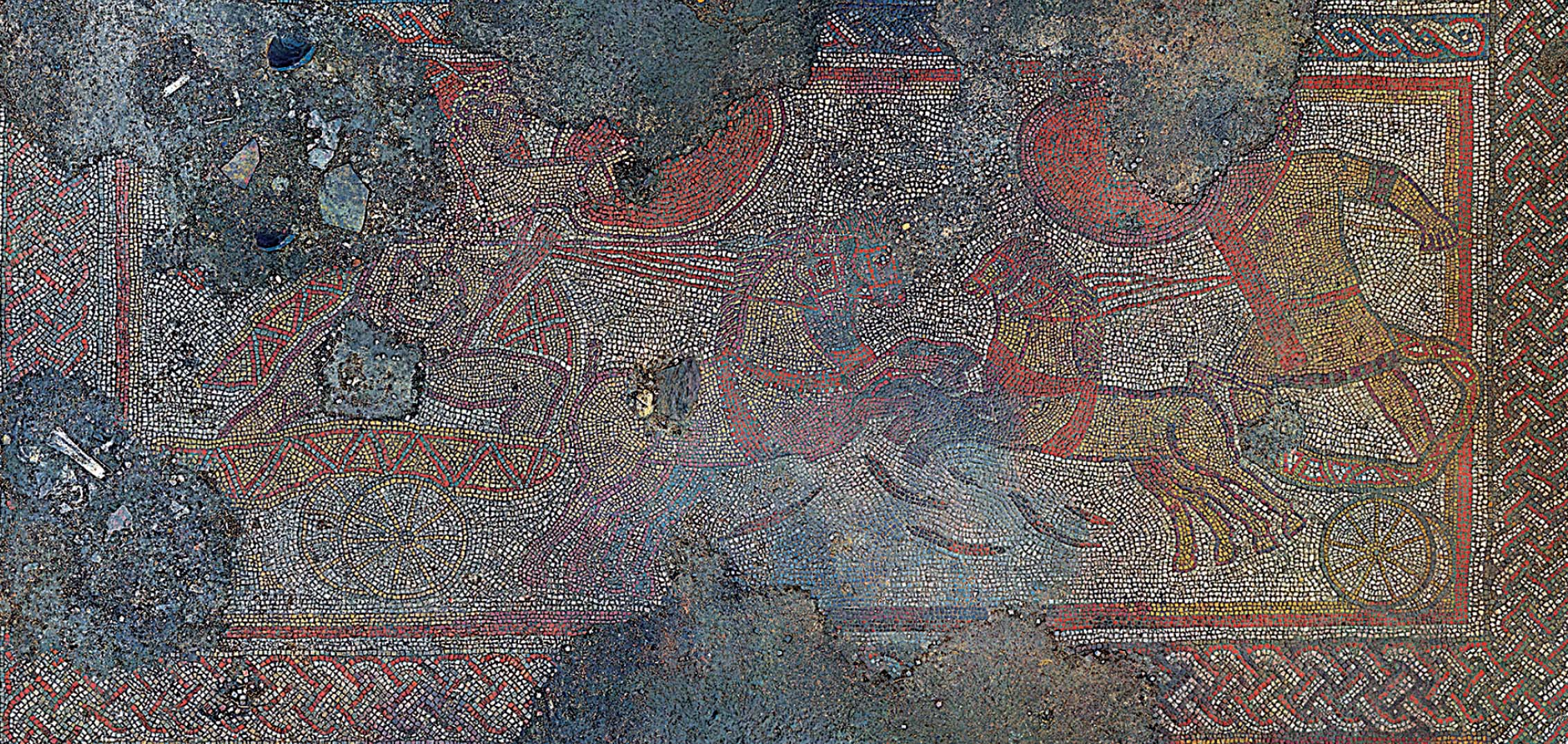Transactions
Members of the Society can download Transactions below.
Past volumes are freely available from the Archaeology Data Service (ADS)
Transactions Volume 96 2022
Hon. Editor: John Thomas, B.A., M.A.
Hon. Editor (Reviews): Peter Walker, LL.B., M.A., Ph.D.
Achilles (left) and Prince Hector of Troy duel from chariots in a scene from the unique Trojan War cycle mosaic discovered at a Roman villa in Rutland

Front cover, prelims
Lynden Cooper, Daryl Garton, Colin Baker, David Budge, Ian Ross, Richard Tyndall
Late Glacial Site Prospection by Test Pit Survey at Bradgate Park Lawns, Newtown Linford
A field survey was conducted at Bradgate Park Lawns in September 2021 as a component of a National Lottery Heritage Fund (NLHF)-funded collaborative project linking three Late Upper Palaeolithic sites in the East Midlands: at Farndon Fields, Bradgate Park and Creswell Crags. This project follows the Ice Age Journeys initiative under the umbrella of the Ice Age Insights charity that promotes community engagement in Palaeolithic archaeology and geology in the East Midlands (registered charity number 1169575). Fieldwork was undertaken by members of the partnership and volunteer fieldworkers, with fieldwork coordination by Lynden Cooper and Daryl Garton, with additional archaeological expertise provided by Prof Nick Barton and Alison Roberts, geological expertise provided by Colin Baker and Richard Tyndall, and pottery expertise by David Budge. Fieldworkers came from the Bradgate Park Trust staff and volunteers, Creswell Heritage Trust staff, Leicestershire Fieldworkers and members of the Farndon (FARI) group. A video of the fieldwork can be viewed at tinyurl.com/BradgateLawns
Richard Huxley, Lynden Cooper, Nicholas Cooper, William Johnson, Suzie Richer, Adam Santer, Rachel Small, Gavin Speed, John Thomas
Prehistoric Ring Ditches and Late Iron Age Activity at Pincet Lane, North Kilworth, Leicestershire
Archaeological investigations by ULAS in 2019, to the east of Pincet Lane, North Kilworth, revealed evidence for a range of activities, notably from the Middle Neolithic, Bronze Age and Iron Age/Early Roman periods. In the Early Bronze Age, a circular palisaded enclosure (c.20m diameter) with a small entrance was constructed. In the centre was a crouched burial with the head orientated south-easterly towards the entrance. Further suspected burials or offerings were also found within the enclosure. Some of these had pots placed into the features, but no bone survived. Later, the entrance was blocked with two posts and the enclosure was redefined with a shallow ditch. A large (c.42m diameter) ring ditch, over 2m in depth, was excavated around the enclosure. The lower part of the ditch had naturally silted, whilst the upper part appears to have been deliberately infilled during the Iron Age period. In the late Iron Age, three roundhouses, and several enclosures, were constructed; some were dug into the top of the outer ring ditch. Evidence indicates one roundhouse was modified during the first century into a ‘C’ shaped enclosure; all of them were used into the Early Roman period. The locations of the Iron Age and Early Roman features suggests that by this point there was no trace of the outer Bronze Age ring ditch in the landscape. In contrast, all the features from this period respect the inner enclosure and the most likely explanation for this is that it was covered by a visible mound. An earthwork may have survived as late as the post-medieval period, as a later trackway may also be respecting this area.
Andrew Simmonds, Carl Champness, Alex Davies, Denise Druce, Elizabeth Kennard, Jennifer Browning
Late Prehistoric Pit Alignments at Money Hill, Ashby-de-la-Zouch
Oxford Archaeology excavated parts of two pit alignments, one of them a double alignment, at Money Hill, Ashby-de-la-Zouch. Pit alignments are notoriously difficult to date and the recovery of small quantities of Iron Age pottery from three of the pits is therefore particularly significant. A localised buried soil layer that contained a small quantity of worked flint of possible Neolithic date was also uncovered.
Jennifer Browning, Jane Masséglia, Jeremy Taylor, John Thomas
The Discovery of a new Roman Villa and unique mosaic in Rutland
In August 2020, investigation of a cropmark identified by landowners resulted in the discovery of a spectacular figurative mosaic on land on the eastern side of Rutland. Following the notification of the Leicestershire and Rutland Historic and Natural Environment Team, a programme of investigation was initiated, and University of Leicester Archaeological Services were appointed to record the trench with support from Historic England. A follow-up programme of geophysical survey, trial trenching and test pitting was implemented to establish the extent, nature and date range of the archaeology, and to assess the risk to the remains from the current farming regime – providing information that would ultimately lead to the designation of the site as a Scheduled Monument. The work has established the presence of an elaborate villa complex, encompassing eight buildings and a host of other structures, enclosed by a ditch system. The excavated areas produced evidence broadly dating it to mid-late third to the late fourth century AD, although there are hints of earlier activity. Unusually, the site has apparently survived as a substantially complete complex, encompassing the full range of buildings that would be expected in a Roman villa, in Britain and is therefore of national and regional significance. However, much of the archaeology was at a shallow depth and therefore potentially at risk from continued cultivation. The mosaic was within a probable dining room at the northern end of a large villa building with an apse, from where it would have been viewed. It depicts scenes from the story of the Trojan War cycle and, in particular, the conflict between Achilles and Hector at Troy. The legend is illustrated in three rectangular panels, each portraying a different act from the tragedy. The inspiration for the imagery is likely to have been taken from an illustrated codex, presumably provided by the proprietor of the villa, marking them out as a highly educated individual. The subject matter of the mosaic is unique in Britain and rare in the rest of the Roman Empire, and it has been described as the most important Roman mosaic to have been discovered in the last 100 years.
Wendy Scott
Evidence for Scandinavian Settlement in Leicestershire – How Portable Antiquities Scheme Data Knits it all Together
Leicester is traditionally listed as one of the ‘five Boroughs’, a contentious name for a number of Midland towns thought by some to have acted as a confederation of Scandinavian settlements within the greater ‘Danelaw’. Also, the south-western boundary of the later county at Watling Street formed part of the documented Danelaw border. The city maintained its Roman walls into the medieval period, which made it a well-located and easily defended central settlement for Scandinavian settlers. Evidence for this Scandinavian settlement has been based on two types of data: documentary, which is most fruitful for the city of Leicester and place name evidence, which is most pronounced in the county. Recently a third source – artefactual, mainly obtained from metal detecting complemented by some excavation – has created a fuller picture, and highlights the value of small finds as cultural markers.
Graham Aldred
A Three-Dimensional Analysis of Leicestershire Early Medieval Place-Names
The following analysis derives from a larger study of Anglo-Saxon settlements in Mercia centred on place-names containing the term worth (Aldred 2021), part of which incorporated a study of the distribution of early place-name types in Leicestershire. This considered their geographical relationships with each other, with landscape features, resources and their relative elevations above Ordnance Datum (AOD), making the study in three dimensions. I had intended to include dating evidence, making it four-dimensional but, apart from the Domesday Book, there is scant evidence for the precise date of establishment of many of these settlements. The overall objective was to determine whether specific name-types exhibited any particularly characteristic patterning. The resultant analysis exposed some distinct patterns, not just in relation to the primary settlement study of worths but to other name-types, which may provide fuel for further research. For example, is it possible to deduce further meaning in addition to simple translations of the names? Do relative locations tell us anything about the organisation of the post-Roman/ early medieval English landscape, its population types and the exploitation of its resources? Whilst habitative names are a matter of human agency, are topographical names purely indicative of specific features or might they also carry more meaning, based on their place in the wider landscape?
David Fogg Postles
‘Trading Beyond His Capital’: The Business of Bankruptcy and Local Economies in Leicestershire, 1706–1842
Whilst the impact of bankruptcy has been investigated by Hoppit, his examination was confined to the eighteenth century, finishing at 1800. His analysis also represented the macro-level, the whole of England. It is important, however, to consider the effects of bankruptcies on local economies, with their different complexions. Bankruptcy is here related to structural change in textile production and financial services. Additionally, the exploration extends to 1842 when District Courts of Bankruptcy were introduced, replacing a previous system that had existed since 1706. A second aspect confirms a recent proposal by Paul that there was a downside to the ‘consumer revolution’: risk and anxiety. Paul’s evidence was derived from insolvent debtors – at the lower level of trading and commerce. Bankruptcy proceedings were restricted to those engaged in higher levels of financial transactions and debt; and so indicate higher levels of risk in the local economy. The new bankruptcy legislation also marked a transition from trust in individuals to trust in institutions; thus an extension of rationalisation into the regulation of the economy.
Gavin Speed
Archaeology in Leicestershire and Rutland 2021
John Thomas
Annual Report & Officers
John Thomas
Obituary
Background image: Trojan mosaic from Transactions 2022 front cover
Trojan mosaic from Transactions 2022 front cover


